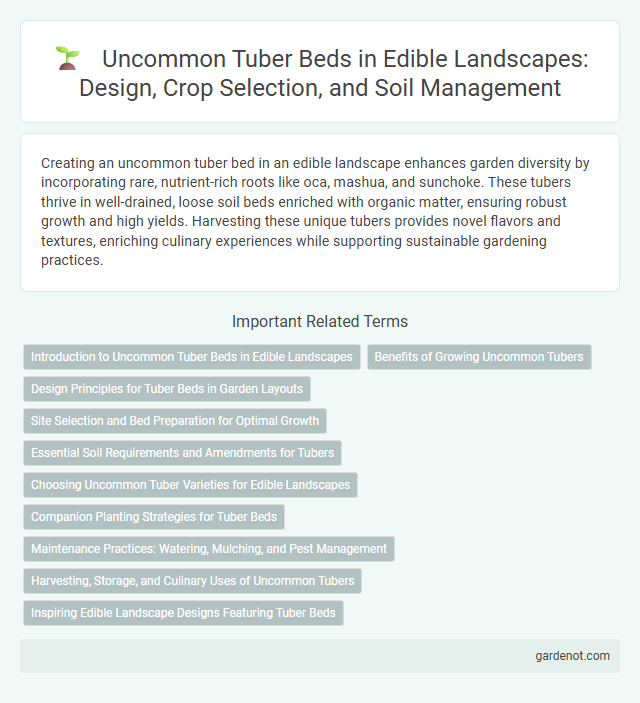Creating an uncommon tuber bed in an edible landscape enhances garden diversity by incorporating rare, nutrient-rich roots like oca, mashua, and sunchoke. These tubers thrive in well-drained, loose soil beds enriched with organic matter, ensuring robust growth and high yields. Harvesting these unique tubers provides novel flavors and textures, enriching culinary experiences while supporting sustainable gardening practices.
Introduction to Uncommon Tuber Beds in Edible Landscapes
Uncommon tuber beds enhance edible landscapes by providing diverse, nutrient-rich root vegetables such as oca, yacon, and mashua, which thrive in unique soil conditions. These tubers offer high yields and are resilient to pests and diseases, making them sustainable options for food production. Incorporating uncommon tuber beds diversifies garden ecosystems while delivering valuable flavors and textures not found in traditional potatoes or carrots.
Benefits of Growing Uncommon Tubers
Growing uncommon tubers enhances biodiversity in edible landscapes by introducing diverse root crops such as oca, yacon, and mashua, which contribute unique flavors and nutritional profiles. These tubers often require fewer inputs and demonstrate resilience to pests and diseases, promoting sustainable gardening practices. Incorporating uncommon tubers enriches soil health through varied root structures and reduces dependency on staple crops, supporting food security and dietary variety.
Design Principles for Tuber Beds in Garden Layouts
Design principles for uncommon tuber beds emphasize soil depth and drainage to support tuber development and prevent rot. Strategic spacing ensures adequate airflow and sunlight exposure, enhancing tuber growth and reducing disease risk. Incorporating companion plants bolsters pest control and enriches soil nutrition, optimizing overall garden health and productivity.
Site Selection and Bed Preparation for Optimal Growth
Selecting a well-drained site with rich, loamy soil and full sun exposure is crucial for cultivating an uncommon tuber bed in an edible landscape. Bed preparation involves loosening the soil to a depth of 12-15 inches, incorporating organic compost and balanced nutrients to enhance soil fertility. Raised beds or mounds improve drainage and root development, promoting optimal tuber growth and yield.
Essential Soil Requirements and Amendments for Tubers
Uncommon tubers such as yacon, mashua, and oca thrive in well-drained, loose soil with a pH between 5.5 and 6.5, promoting optimal tuber development and preventing rot. Incorporating organic matter like compost or aged manure enhances soil fertility and structure, improving moisture retention while preventing compaction. Balanced amendments including potassium and phosphorus support tuber growth, while avoiding excessive nitrogen prevents excessive foliage at the expense of tuber size.
Choosing Uncommon Tuber Varieties for Edible Landscapes
Selecting uncommon tuber varieties such as oca, mashua, and yacon enhances biodiversity and visual interest in edible landscapes while providing unique flavors and nutritional benefits. These tubers thrive in diverse soil conditions and offer resilience against pests and diseases, reducing the need for chemical inputs. Integrating rare tuber species promotes sustainable gardening practices and supports local food sovereignty by preserving heirloom plant genetics.
Companion Planting Strategies for Tuber Beds
Companion planting strategies for uncommon tuber beds enhance growth and pest resistance by selecting complementary species like garlic, which repels nematodes, and marigolds, known for deterring root maggots. Incorporating nitrogen-fixing plants such as clover improves soil fertility and tuber development, while aromatic herbs like thyme attract beneficial insects that aid in natural pest control. These carefully chosen companions create a balanced ecosystem, optimizing tuber yield and health in edible landscapes.
Maintenance Practices: Watering, Mulching, and Pest Management
Maintaining an uncommon tuber bed requires careful watering to keep soil consistently moist but not waterlogged, promoting healthy tuber growth. Applying organic mulch helps regulate soil temperature, retain moisture, and suppress weed development around the plants. Effective pest management involves regular monitoring for common tuber pests like wireworms and implementing natural controls such as neem oil or beneficial nematodes to protect the crop.
Harvesting, Storage, and Culinary Uses of Uncommon Tubers
Harvest uncommon tubers such as oca, mashua, and yacon once their foliage yellows, typically between late autumn and early winter, ensuring tubers have developed maximum starch and flavor. Store harvested tubers in a cool, dark, and dry environment with good ventilation to prolong shelf life, avoiding moisture that can cause rot or sprouting. Culinary uses of these tubers vary from roasting and boiling to pickling and raw consumption, offering unique textures and flavors ideal for salads, stews, and root vegetable medleys.
Inspiring Edible Landscape Designs Featuring Tuber Beds
Uncommon tuber beds create striking focal points in edible landscapes by showcasing diverse varieties like oca, yacon, and mashua, which thrive underground while adding vibrant texture above. Integrating these tubers into raised beds or mounded rows maximizes soil drainage and nutrient availability, promoting robust growth and harvest yields. These designs not only enhance biodiversity but also offer unique flavors and nutritional benefits, inspiring gardeners to innovate beyond traditional root crops.
Uncommon tuber bed Infographic

 gardenot.com
gardenot.com